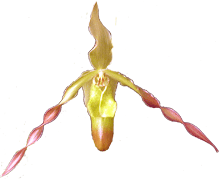New Orchid Care
Acquiring a new orchid is a pleasure. If it is in bloom, we can expect to enjoy the bloom for many weeks. A new orchid is also an unknown. Here are some things to keep in mind:
Keep the new orchid isolated from the rest of the collection for a few days on the off chance that it has something wrong with it that could harm the other plants. Sometimes bugs or disease travel on new orchids and before we know it the entire collection is affected. Simply keeping a new orchid away from the others for a bit will guard against this.
We don't really know what may have happened to an orchid before we acquire it. If the plant was mailed to us it may have been subjected to very high or low temperatures in transit. If the plant is coming from a grocery or hardware store it may have other stresses from being dried out or indoors away from sun or left out in the truck too long in cold weather before being unpacked and moved indoors. Orchids left in a car while shopping can be exposed to temperature extremes as well. Orchids can be slow to exhibit signs of damage so it is possible to buy a plant that looks healthy one day and starts dropping leaves like crazy the next. Bud blast, where new flower buds dry up and drop off without opening, is also seen in new acquisitions often through no fault of the new owner.
Even in the best of conditions, new orchids need time to adjust to their new home. Invariably the light, humidity, water, etc. is different than the greenhouse where they were grown. They may not rebloom at the same time the following year due to the different conditions. In some cases, if an orchid was acquired in bloom, the next bloom may not be the same exact color (though it will be close) as bloom color can be affected by light and temperature in some orchids.
After a new orchid blooms we like to repot it. This accomplishes a few goals. First, we can get a good look at the roots and assess the general health of the plant. Second we can move it into an orchid mix that is consistent with our other orchids. Finally we can put it in a larger pot if appropriate.
An orchid comes potted in the media or mix that works best for the grower and not necessarily the one that will work best in the orchid's new home. For example, a new orchid may come potted in very tightly packed sphagnum moss. This may be because the grower has very hot, arid conditions with a lot of air movement and the tightly packed sphagnum allows the plant to hold enough moisture between waterings in their greenhouse. Sphagnum is very light to ship and plants potted in it often do well in transit as the sphagnum doesn't become too dry or spill out of the pot. Unfortunately, in some cases this same orchid if moved into a windowsill with limited air movement, ample water and moderate temperatures may become sodden and then the roots rot. Simply blaming sphagnum isn't the answer, if it were packed lightly the plant would likely have done just fine. The answer is that the orchid needs to be potted in a way that is consistent with its new environment, not its former environment.
Moving a new orchid from one type of mix to another can be stressful for the plant as the roots may take a little time to adapt. In our experience an orchid can usually be moved between various media with good results. There is one exception to this rule which involves moving an orchid from sphagnum to fir bark. We believe better results can be obtained if the first repotting is 50/50 sphagnum and fir mix before moving to an exclusively fir mix. The other direction, moving an orchid from fir to sphagnum doesn't seem to be an issue.
In some cases a newly acquired orchid is in a fresh mix that is suitable for its new environment and it is not growing out of its pot and the orchid will be just fine in the same mix for another season. Orchids cannot stay in the same mix indefinately, however, eventually the mix breaks down and smothers the roots.
More Information on:
- Orchid Care Basics
- Phalaenopsis
- Cattleya
- Orchid Repotting Clinic
- Orchid Growth Patterns
- Orchid Calendar










